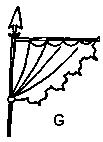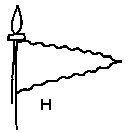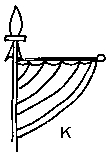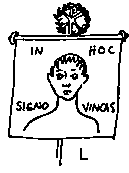Early Banner Types
You've gone to all the trouble of researching an early period persona and designing and early period device and now your going to display it on a heater-shaped banner like everybody else, right? Here are some ideas for alternate banner types so you can stand out in a crowd.
A standard based on Roman legionary types might be a good idea for a group or household that is predominately from that time period. Many peoples who fought against the Roman empire adopted standards and banners based on Roman ones. Make allowances for your tribal or clan affiliations. Barkers' book is especially good for its depiction of legionary devices, standards and shield patterns. It is also a good source for devices from that period. For a more detailed description of standards, see Barker, pp. 79-82.
Figure A shows three types of vexilla, flags hung from crossbars, used by Celts in imitation of the Romans. The Sarmatians favored the Vexillium as a banner also.
Besides the Aquila and Signum familiar from the movies (those are the ones with all the medals and wreaths hanging on them), Romans also carried standards topped with animal badges associated with particular units. They were mounted on top of an otherwise bare pole. This custom was adopted by the Gallic and British Celts. The most popular animal was a silver or bronze cock, with the boar placing a close second. Bulls and stags were also used. (Figure B)
Other banners used by non-roman peoples during this period include Figure C which is Dacian. The Sassanids (Persians) had some interesting banners based on Figure D. Also used were variations of the vexillium and pennon. Figure E is a Blemye (Sudanese) standard, sort of a cross between the animal standard and the vexillium with bells attached.
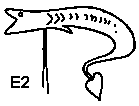 Psalterium Aureum (St. Gall, Switzerland), 880 A.S., shows a swallowtail banner with balls or possibly bells decorating the tails. Another interesting banner from the same manuscript shows a 'dragon' or fish-like beast on a pole (Figure E-l). This type of of banner goes back to the Roman Draconarius (late 2nd to 5th c. A.D.). Saxons are known to have had banners of this sort that whistled. The open mouth could have contained a type of Aeolian harp or reeds which produced a whistling sound when moved in the wind. Some early examples seem to have a carved head with a cloth tail (the head of the Roman Draco was silver) shaped like a windsock, while others appear to be composed of cloth only. The Dacians also favored the Draco. (Figure E-2)
A ninth century mosaic in Rome shows Charlemagne receiving the Imperial banner. The banner is purple, powdered with eight-pointed gold stars. (Figure F)
The Psalter of St. Bertin (northern French, c. 1000 B.C.) shows a banner suspended from a bar attached to a spear. The edges appear to be dagged, looking almost like animal claws. (Figure G)
Psalterium Aureum (St. Gall, Switzerland), 880 A.S., shows a swallowtail banner with balls or possibly bells decorating the tails. Another interesting banner from the same manuscript shows a 'dragon' or fish-like beast on a pole (Figure E-l). This type of of banner goes back to the Roman Draconarius (late 2nd to 5th c. A.D.). Saxons are known to have had banners of this sort that whistled. The open mouth could have contained a type of Aeolian harp or reeds which produced a whistling sound when moved in the wind. Some early examples seem to have a carved head with a cloth tail (the head of the Roman Draco was silver) shaped like a windsock, while others appear to be composed of cloth only. The Dacians also favored the Draco. (Figure E-2)
A ninth century mosaic in Rome shows Charlemagne receiving the Imperial banner. The banner is purple, powdered with eight-pointed gold stars. (Figure F)
The Psalter of St. Bertin (northern French, c. 1000 B.C.) shows a banner suspended from a bar attached to a spear. The edges appear to be dagged, looking almost like animal claws. (Figure G)
 The triangular banner or pennon attached to a lance goes back to Roman times. You can believe the story that its purpose is to keep blood from running down the shaft and making the handgrip slick; or not, as you choose. Figure H is a variation on a triangualar shape, but with wavy edges. It is from northern Spain, 10th century.
Figures I and J are both from northern Spain, approximately 975 A.D.
Figure K is Carolingian, late ninth century and is based on Byzantine types.
Figure L is the famous Labarum of Constantine I. You remember the story, "In this sign, conquer".
The Scylitzes Manuscript (Byzantine), based on an 11th century originals, shows two types of swallowtailed banners. Figure M allows for a device to be displayed on the rectangle. Figure N would best display colors. Figure O is a larger variation on Figure M. Banners similar to these with shorter tails were shown in the Bayeaux Tapestry.
Sources:
The triangular banner or pennon attached to a lance goes back to Roman times. You can believe the story that its purpose is to keep blood from running down the shaft and making the handgrip slick; or not, as you choose. Figure H is a variation on a triangualar shape, but with wavy edges. It is from northern Spain, 10th century.
Figures I and J are both from northern Spain, approximately 975 A.D.
Figure K is Carolingian, late ninth century and is based on Byzantine types.
Figure L is the famous Labarum of Constantine I. You remember the story, "In this sign, conquer".
The Scylitzes Manuscript (Byzantine), based on an 11th century originals, shows two types of swallowtailed banners. Figure M allows for a device to be displayed on the rectangle. Figure N would best display colors. Figure O is a larger variation on Figure M. Banners similar to these with shorter tails were shown in the Bayeaux Tapestry.
Sources:
Barker, Phil The Armies and Enemies of Imperial Rome. Wargames Group Publication, 1981.
Nicholle, David The Age of Charlemagne. Osprey, 1984. (Osprey Men-At-Arms Series #150).
Wilcox, Peter Rome's Enemies: Germanics and Dacians. Osprey, 1982. (Osprey Men-At-Arms Series #129).
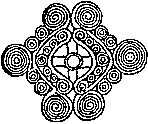 Back to Early Period #2 |
Back to Early Period Index |
Back to PastTimes
Back to Early Period #2 |
Back to Early Period Index |
Back to PastTimes








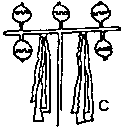
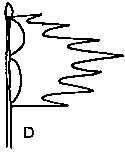

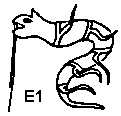
 Psalterium Aureum (St. Gall, Switzerland), 880 A.S., shows a swallowtail banner with balls or possibly bells decorating the tails. Another interesting banner from the same manuscript shows a 'dragon' or fish-like beast on a pole (Figure E-l). This type of of banner goes back to the Roman Draconarius (late 2nd to 5th c. A.D.). Saxons are known to have had banners of this sort that whistled. The open mouth could have contained a type of Aeolian harp or reeds which produced a whistling sound when moved in the wind. Some early examples seem to have a carved head with a cloth tail (the head of the Roman Draco was silver) shaped like a windsock, while others appear to be composed of cloth only. The Dacians also favored the Draco. (Figure E-2)
A ninth century mosaic in Rome shows Charlemagne receiving the Imperial banner. The banner is purple, powdered with eight-pointed gold stars. (Figure F)
The Psalter of St. Bertin (northern French, c. 1000 B.C.) shows a banner suspended from a bar attached to a spear. The edges appear to be dagged, looking almost like animal claws. (Figure G)
Psalterium Aureum (St. Gall, Switzerland), 880 A.S., shows a swallowtail banner with balls or possibly bells decorating the tails. Another interesting banner from the same manuscript shows a 'dragon' or fish-like beast on a pole (Figure E-l). This type of of banner goes back to the Roman Draconarius (late 2nd to 5th c. A.D.). Saxons are known to have had banners of this sort that whistled. The open mouth could have contained a type of Aeolian harp or reeds which produced a whistling sound when moved in the wind. Some early examples seem to have a carved head with a cloth tail (the head of the Roman Draco was silver) shaped like a windsock, while others appear to be composed of cloth only. The Dacians also favored the Draco. (Figure E-2)
A ninth century mosaic in Rome shows Charlemagne receiving the Imperial banner. The banner is purple, powdered with eight-pointed gold stars. (Figure F)
The Psalter of St. Bertin (northern French, c. 1000 B.C.) shows a banner suspended from a bar attached to a spear. The edges appear to be dagged, looking almost like animal claws. (Figure G)
 The triangular banner or pennon attached to a lance goes back to Roman times. You can believe the story that its purpose is to keep blood from running down the shaft and making the handgrip slick; or not, as you choose. Figure H is a variation on a triangualar shape, but with wavy edges. It is from northern Spain, 10th century.
Figures I and J are both from northern Spain, approximately 975 A.D.
Figure K is Carolingian, late ninth century and is based on Byzantine types.
Figure L is the famous Labarum of Constantine I. You remember the story, "In this sign, conquer".
The triangular banner or pennon attached to a lance goes back to Roman times. You can believe the story that its purpose is to keep blood from running down the shaft and making the handgrip slick; or not, as you choose. Figure H is a variation on a triangualar shape, but with wavy edges. It is from northern Spain, 10th century.
Figures I and J are both from northern Spain, approximately 975 A.D.
Figure K is Carolingian, late ninth century and is based on Byzantine types.
Figure L is the famous Labarum of Constantine I. You remember the story, "In this sign, conquer".
